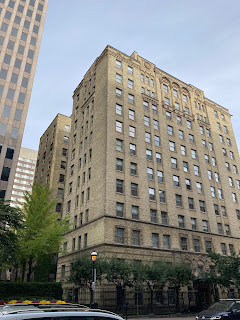I started watching a series called 3 Blocks, 30 Quilts to prepare for the sock quilt that has been cooling in a shoebox for too long. The instructor Kate Collaran is quite inspiring. She has a company that designs quilt patterns called Seams Like a Dream Designs.
She suggests colour families, and then pulls in an accent colour. She recommends a pop of colour, with the idea that if you have two complimentary colours, a third is necessary to bring in a contrast. She also sees colour families, or themes to pull colour together. If you have a beautiful complicated fabric, you can use it as an inspiration to pull the colours together for your quilt.
She suggests that you design patterns in a notebook with pencil crayons, which is what I like to do when I see a pattern that inspires me (the last one was from a scene from Shang-Chi).
She talks about 1 block quilts, log cabins, four patch, and pinwheels! Start at a corner at bottom right, and at a strip to the top, then the left side, until your block is done.
Don't forget to measure twice; cut once.
Use your iron, and "press" your fabric to start, once seams are sown, press flat, closed, then on the back, creating a four patch pinwheel to lay flat in behind, and then at each additional piece.
She has a cutting mat that seems like a great size, and encourages the use of 2 rulers without turning your fabric. She uses a rotary cutter, and cuts multiple strips by multiplying and cutting a 6' strip before cutting it in half for 2-3' strips to minimize moving the fabric.
Sewing strips together, she gets a "good" quarter inch seams but starting the seam before she gets to her sewing foot with a guide. She recommends painter's tape as low residue. She recommends sewing slowly and steadily, don't "swing wide" at the beginning, and "following through" by getting all the way off before rushing the end of the seam.
Cross cutting units tidies up the edges to get rid of "wonky bits", of which I think I might have many.
Once you have 12, 24, or 48 blocks, you can arrange the setting of them all following all sorts of patterns. Each block is 12 inches. A large quilt is 48 blocks. A small quilt is 24.
If you are drawing on your squares (with half square triangles), you can glue a sandpaper on cardboard and draw without the fabric moving.
The squares can be sewn as squares with centre seam allowances, then cut after the fact. Trim your dog ears before joining the next two triangles. This is advanced level!
Frixion pen ink disappears with ironing.
Another great resource is





